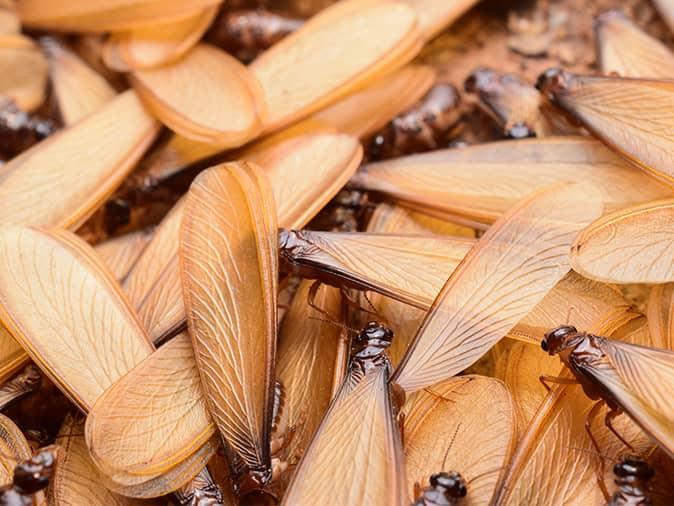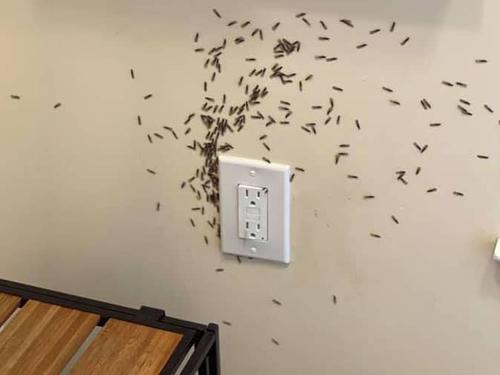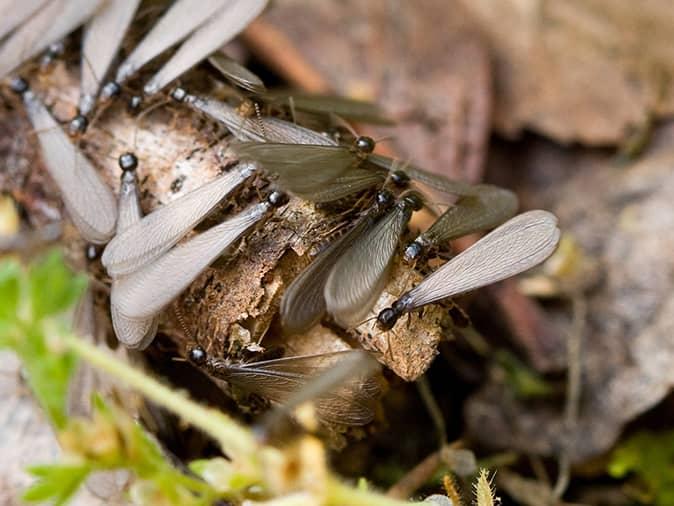There are many insects that can damage our property. They chew our clothes, our drapes, and even our wallpaper. The worst ones chew on wood products. These are called wood-destroying organisms. They can put holes in antique furniture, carve tunnels into decks, and even carve out large galleries inside the wood of man-made structures. And, in the category of wood-destroying organisms, the subterranean termite is top of the list. This is because subterranean termites have behavior patterns that help them elude detection. When you have carpenter ants destroying your property, you're likely to see a few carpenter ants crawling around here and there. When you have carpenter bees boring tunnels into your property, you're going to see them and hear them. Even tiny wood-boring beetles give themselves away by creating many tiny holes in the hardwood products they chew into. Signs of subterranean termites are often subtle or misinterpreted. We're going to take a look at one sign every home and business owner needs to recognize: The appearance of subterranean termite swarmers.
In our New Jersey service area, the termite we battle most is the Eastern subterranean termite. This species of termites is the most distributed termite in North America and can be found on the East coast as far north as Ontario, Canada and as far south as Key Largo, Florida. For the purposes of this article, we'll be focusing on this species. If you're concerned about another species of termite, you can still find valuable information here. Subterranean termite swarmers share many of the same characteristics and behaviors.

Termites can be very difficult to detect
The Eastern subterranean termite is designed for covert operations. These insects establish their nests in the ground and tunnel through the ground to find food. When they encounter a man-made structure that has wood touching the soil, they can tunnel straight into the wood and begin removing it a bite at a time. If termite damage goes undetected, it can have a cascading effect. Weakened support timbers can put stress on the whole structure and lead to widespread and irreparable damage. But all termites are not stealthy.
What is a termite swarmer?
Termite swarmers are male and female alates that are produced by a mature nest for the purpose of establishing new nests. Unlike other termites in a colony, swarmers are attracted to light. For this reason, these termites are often found on the inside of windows in a structure that has an active infestation. They want to be outside in the bright sun, not inside the dim interior of a home or business. If you see swarmers inside, it is important that you understand that it is a warning sign of a current and mature infestation, not an impending infestation.
Termite swarmers on the exterior of your home
What does it mean when swarmers appear on the outside of a building? It can still be a warning sign of an impending infestation. When male and female alates take to the air, they form into a swarm and mate. Once this mating is done, they separate in search of nesting locations. If you see a few swarmers here and there, it could be an impending infestation. But when dozens are crawling around on your outside wall, it is more likely that they came from a mature nest on your property.
The anatomy of a termite swarm
When swarmers gather into a swarm, that swarm only lasts around a half hour and the swarm does not travel very far. It may come and go without you ever seeing it. For this reason, it is important to recognize the secondary signs of a termite swarm, which are the presence of the wings that are shed by termite swarmers during the mating process. These wings will be mostly equal in length and have a white coloration. If you find them on the inside, they are likely to be on window sills or the floors underneath windows or glass doors. If you find them on the outside, they will be on any surface or littered in mulch or other wood products on the ground. Male and female swarmers search for an ideal location to create a nest before they mate. It is important that you understand what conditions are ideal for termite swarmers.
Common places you'll find termites on your property

Termite swarmers do not eat wood but they are attracted to it, especially if it is decaying. When they create their nests, they want their offspring to be able to quickly and easily find a meal. If you have any of the following conditions in your yard--or conditions that are similar--you will attract termite swarmers:
- The wood of your home or business touches the soil.
- You have wood fencing, especially fencing that is moist where it touches the ground.
- Shaded locations that have wood debris on the soil.
- Wood debris laying against exterior walls.
- Wood or brush piles that touch the ground in your yard or wood stacked near your exterior walls.
- Flower beds that are lined by wood.
- Areas of mulch, especially damp mulch.
- Wood construction materials on the ground.
- Crawl Spaces under a home or business that has wood, cardboard, or paper products stored on the ground.
Termite Swarmers are also drawn to moist conditions. Termites require a lot of moisture to survive. By establishing a nest in a moist location, queens and kings ensure the best chance of success for their offspring. The following may create moist conditions on your property:
- Obstructed or broken gutters can allow water to pool and run down the side of your structure, making the ground wet. Not only is this bad for the wood, it will draw termite swarmers in.
- Plumbing leaks and weeping pipes can lead to saturated soil and wood.
- Condensation in crawl spaces and wet basements will make termites feel right at home.
- Broken downspouts can create pools of water near your foundation instead of channeling rainwater away from your structure.
- Compacted soil can allow rainwater to sit.
- The shade created by trees, bushes, vegetation, and external structures such as decks, balconies, stairs, etc., can prevent rainwater from drying up quickly in the sun.
- Flower beds and ornamentals require watering. If these are close to foundation walls, all of that moisture is going to be inviting for swarmers.
While termite swarmers are drawn to light, they will establish their nests in dark locations after they have shed their wings and mated. This will cause them to go under slabs of wood structures that provide a cover of darkness.
Termites don't just eat wood. They eat any material that has cellulose. For this reason, swarmers may choose a location that has plant material, root systems, or overgrowth. They may even create a nest under a garden, especially if there is corn in the garden.
How to recognize an eastern subterranean swarmers
Male and female alates of the species Reticulitermes flavipes (Kollar) are dark-brown or black in color and between ⅜ to ½ of an inch in length. They have two pairs of white, translucent wings that are of equal length and stack on top of each other.
It is important to be able to properly distinguish termite swarmers from ant swarmers. There are many species of ant and only one of them destroys the wood of man-made structures, those are called carpenter ants.
All ant swarmers have a pinched waist and wings that have a cleft at the tips. Termite swarmers do not have a pinched waist; they are more of a pill shape and their wings are round at the tips.
Carpenter ants are the largest ants that invade homes and businesses and they are drawn to the same conditions as termites swarmers. Their size should help you to quickly distinguish them from termite swarmers. A carpenter ant swarmer is ¾ to 1 inch in length and, because of its size, you should be able to easily see its pinched waist and the single node between its thorax and abdomen.
What time of year can you expect to see swarmers?
There isn't necessarily a termite season but spring in New Jersey is often when we see swarms. This is because termite swarmers wait until it is warm enough, and wet enough, to ensure the development of a successful nest. After the last freeze and usually when temperatures rise up above 70 degrees is when swarmers get sent out. But they can be released from a termite nest any time temperatures rise. This activity in spring leads some to believe that termites are only active in the spring but termites can feed on man-made structures all year long, 24 hours a day, under the right conditions.
How do termite swarmers get in to my New Jersey home?

Termite swarmers will usually begin a nest in the soil outside of a man-made structure, but they can establish a nest inside as well. If you have a basement with a dirt floor, a dirt crawl space, or a portion of your structure that is soaked with moisture, subterranean termites can establish a nest inside. This can be countered with the following:
- Inspect your foundation and exterior walls and seal any gaps, cracks, or holes. Termite swarmers don't chew their way in. They need an entry point. A caulking gun is a great tool to get this done.
- Have a professional encapsulate your crawl space to keep it dry under your home and keep pests out.
- Create a dry barrier around your home.
- Replace mulch with crushed stone.
- Trim bushes and trees to allow the sunlight to quickly dry up water after it rains.
- Make sure to immediately address plumbing issues. If you have a leaky outdoor spigot or hose, it can saturate the ground and create the dampness that termites need.
- Repair structural problems that can give rainwater entry. While Eastern subterranean termites rarely establish a nest above ground, they are able to do it when there is enough dampness in wood.
When do termite colonies produce swarmers?
There is no specific age a nest must be to begin sending out swarmers but it usually takes three or more years for a nest to develop to a stage where it is necessary to develop male and female reproductives.
What to do when you find termite swarmers
There are many ways you may discover termite swarmers. You might peel back a layer of mulch and find hundreds of white-winged insects crawling around. You might notice a hole in a floor and see white-winged insects pouring out of it. You may break apart a stump or log on your property and see swarmers mixed with hundreds of pale insects. You might see swarmers crawling all over a wall or congregating on a window. You could find them gathered on your walkways, driveway, deck, or some other outside surface by the hundreds or even thousands. Whatever way you see them, be sure to recognize them for the warning sign they are and contact a professional. Spraying them with soapy water or sucking them up with a vacuum will not solve the problem.
Incorrect termite treatment methods
A PMP will not use a topical spray to deal with a termite infestation. Your PMP will not use a treatment plan that only targets the swarmers. Pest management works to address the core problem, not simply the symptom of the problem. And your PMP will not suggest a bait solution. Bait takes months to work. During that time, termites can continue to feed on your property and eat away at your equity.
Treat before swarmers appear & have a plan
Termite control should be proactive. Along with the preventative measures listed above, it is important to have a trusted and certified professional install a termiticide barrier around your property to prevent termite infestations from taking root.
Five reasons to be proactive about termite control
- Subterranean termites are a billion dollar problem in the United States and do more damage than all natural disasters combined.
- Termites are sneaky by nature. Swarmers are one of the only signs you may get that your property is being damaged.
- When you see swarmers, it is likely that damage has already been done and that there is a mature infestation on your property.
- Termite swarms don't last long. Don't take the chance of missing this important warning sign.
- Termites can travel hundreds of yards to feed on your property. That means the termite colony that is feeding on your property may be far enough away that you never see the release of swarmers into the air.
Professional termite control services in New Jersey
If you have more question about Eastern subterranean termite swarmers reach out to us. The experts here at Arrow Pest Control have the experience and education to address your questions and give you actionable information to protect your property from termite damage.
If you own a home or business in New Jersey, go here to establish termite service for your property. We provide proactive termite protection with a one-year renewable warranty. We can also provide a comprehensive termite inspection that includes the completion of the NPMA-33 report--if you're in the process of purchasing a property.
No home or business should be without termite protection. Get yours in place today.
Arrow Premier
If you’re looking for a program that protects your home and family from common household pests PLUS termites and other wood-destroying insects, we recommend Arrow Premier. With this program, you get quarterly pest control and a wood-destroying insect program in one package!
- Protects your home all year long.
- Consists of full interior and exterior inspections and treatments.
- Covers your entire property* including the attic, mailbox, play set, shed, and fence.
- Includes a certified termite inspection and ongoing termite control.
Pests targeted with Arrow’s Premier includes cockroaches, silverfish, spiders, earwigs, clover mites, millipedes, centipedes, crickets, ground beetles, boxelder bugs, ants (including carpenter ants, pharaoh ants and acrobatic), fleas (inside only), pillbugs, sow bugs, fruit flies, stored product pests, bees, wasps, hornets, carpenter bees (no higher than 10ft), mice, and rodents PLUS termites
*If you have a pool house that requires service, pricing would increase based upon the size of the structure.


Testimonials
Request Your FREE Estimate
Additional Services
Our solutions are designed for even your toughest pest problems.
Don’t let pests affect your quality of life, here's how we can help:
